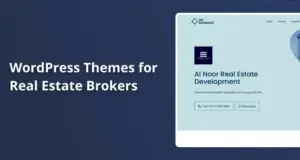Many real estate professionals build WordPress sites to display listings and property details. These sites can start with only a few properties but might expand to thousands of entries over time.
Google Cloud Platform (GCP) offers various hosting models that can handle smaller sites, massive sites, and everything in between. Each approach has pros and cons regarding cost, performance, and the work required.
A real estate website built on WordPress often needs room to grow. New agents might add more listings, or you might create advanced features such as interactive maps, email alerts, or virtual tours. GCP can adjust to these needs with services like Compute Engine, App Engine, Cloud Run, and Google Kubernetes Engine (GKE), and all these can be linked to a managed database, object storage, and a content delivery network.
This guide covers how these GCP solutions compare to WordPress hosting. Each approach is very detailed, so it helps to begin with a broad overview before diving into details.
Why GCP for Real Estate Websites
A real estate site must handle more than a basic blog. Property photos, dynamic listing data, and potential spikes in traffic require robust hosting. Some owners prefer a simple virtual machine. Others want a managed or serverless method. GCP has a vast toolbox:
- Compute Engine (CE): A classic virtual machine (VM) approach
- Google Cloud Marketplace: Pre-configured WordPress images on CE
- App Engine Flexible: A managed platform for web applications
- Cloud Run: Serverless containers that scale from zero to many
- GKE: A Kubernetes cluster service for custom container setups
Most real estate sites also need these supporting services:
- Cloud SQL: A managed MySQL or Postgres database
- Cloud Storage: Object storage for uploads like property images
- Filestore: Network file system for shared directories, typically for advanced multi-instance setups
- Cloud CDN: Distributes cached content around the globe
Some projects stick to one small VM and skip everything else. Others run in a container-based environment with auto-scaling. There is no single recipe for every site, and because of that, the choice depends on the number of listings, how fast the site might grow, and your budget.
Compute Engine or Marketplace: Easiest Starting Point
A single VM is the most straightforward approach to hosting WordPress on GCP. You can install WordPress manually on Linux or use Google Cloud Marketplace to deploy a ready-made WordPress image.
Single VM Basics
Many smaller real estate sites run fine on one virtual machine. You pick your desired CPU, RAM, and storage, then install the usual LAMP stack (Linux, Apache, MySQL, PHP). GCP’s smaller VM types (micro or small) can cost as little as a few dollars per month, which includes the persistent disk and the essential resources. A site with under 100 listings might do well on one of these lower-tier instances, especially if you add a caching plugin.
This model does not have auto-scaling, and you must manage the server yourself. That includes OS updates, applying security patches, and upgrading the VM if traffic grows.
Using a single VM also creates a single point of failure. If it fails, the site is down. Snapshots can protect your data, but you still handle most maintenance on your own.
Most beginners like this path because of its simplicity and control. It will feel familiar if you already know how to manage a WordPress site on a Linux server. It is also easy on the budget at lower scales.
Pros
- Very low cost for light traffic, often only a handful of dollars
- It is straightforward for anyone used to typical VPS hosting
- Complete freedom to install any plugin or tweak settings
Cons
- There is no automatic scaling, so you must watch traffic levels
- Single point of failure on one VM
- Manual upkeep, which can be time-consuming

Marketplace One-Click Deployment
GCP Marketplace offers WordPress images from Bitnami or Google Click-to-Deploy. These are nearly identical to a single VM, but the WordPress environment is pre-installed. You launch it with a few clicks, set a password, and have a working WordPress site in minutes. The underlying cost is the same as that of a regular VM. The advantage is time saved during setup.
Once running, you still manage updates and overall server health. There is no built-in multi-instance feature. For bigger spikes in traffic, you either upgrade the VM size or move to a more advanced pattern.
App Engine Flexible
App Engine Flexible offers a managed platform for web apps without configuring your VM images. It can automatically spin up more instances based on traffic, then drop back to fewer instances when traffic falls.
This is attractive for a site that faces busy times. The trade-off is a higher monthly baseline. Even when idle, App Engine Flex keeps at least one instance alive, costing around 40 USD monthly.
The database usually lives in Cloud SQL, which adds a separate fee. Typical minimal setups might cost around 45–60 USD a month, including a small Cloud SQL. That price is not a bargain for a brand-new real estate site with minimal traffic, but it spares you from OS patching or VM reboots.
To run WordPress here, you must adapt it to the app engine’s ephemeral storage. Files belonging to wp-content/uploads may need to go to Cloud Storage through a plugin, and Cloud SQL credentials must be passed through environment variables.
These tasks are simple for someone familiar with coding yet trickier for someone without experience and more complicated than a single VM.
App Engine is designed to handle moderate or high usage. Each new request can be routed to an existing instance, or if the load grows, more copies of the app appear. That helps a real estate site with unpredictable traffic. You won’t be stuck scrambling to spin up new servers.
Pros
- No direct server administration
- Auto-scaling for busy periods
- Suitable for consistent or moderate traffic
Cons
- A baseline cost that is higher than a micro VM, even when the site is idle
- Setup is more complex than a Marketplace VM
- A single instance must always run, so no scale-to-zero savings
App Engine can work well for those who want a managed environment but do not mind paying for that convenience. The WordPress code belongs to you, yet GCP handles the platform layer. That approach can be a relief if you value less hands-on server work.
Cloud Run (Serverless Containers)
Cloud Run is a serverless container service. You package WordPress in a Docker container, deploy it, and let Google handle auto-scaling, load balancing, and overhead. Cloud Run scales to zero if no one visits the site, so you pay nothing for that idle time. If traffic grows, Cloud Run spins up more containers in seconds.
A real estate site using WpResidence and MLSimport might need to adjust its storage of property images in Cloud Storage. The database usually sits in Cloud SQL. Any changes you make through the WordPress admin area that affect the code (like installing a plugin) are temporary.
Once the container restarts, those local changes vanish. The recommended workflow is to place your theme and plugins in source control, rebuild the container, and then redeploy. That is not the typical approach for many casual WordPress users, but it’s a modern method that can reduce headaches at scale.
Light-traffic real estate sites might pay under 10 USD a month if their usage is small since Cloud Run has a generous free tier. The main cost often comes from the Cloud SQL database. As traffic rises, Cloud Run containers multiply. The cost can climb, but only in proportion to actual usage. This dynamic billing is often cheaper than paying for an idle VM or an App Engine instance if your traffic is not steady.
Pros
- Auto-scaling from zero to many containers
- Only pay for CPU time while requests are processed
- Very little maintenance or patching of servers
Cons
- Containerizing WordPress is more complex than a one-click VM
- There is no local file storage, so images go to Cloud Storage or a similar
- On-the-fly plugin updates in WP Admin do not persist after redeploying
Cloud Run suits real estate websites with unpredictable traffic or a developer team that appreciates Docker-based workflows. Many site owners pick it to save money until traffic grows to a point where the monthly usage is consistently high.
Google Kubernetes Engine (GKE)
Kubernetes is an orchestration system for containerized applications. GKE runs Kubernetes clusters on Google’s cloud. WordPress can sit in pods, the database in Cloud SQL, and file uploads on Cloud Storage or a shared filesystem. GKE can autoscale pods or even add more nodes to the cluster as the load rises. This approach is the most advanced in GCP’s stack.
It also requires the most technical skill. You must manage a cluster, define configurations through YAML or Helm charts, and maintain node pools. Larger real estate sites with high traffic can do well on GKE, especially if multiple apps need to run side by side.
A single WordPress site with one or two employees might not need that overhead.
Costs start with at least one node you pay for all the time. If you enable more nodes, your bill goes up. Even at a small scale, GKE might cost 25–40 USD monthly for a minimal node plus the database. That’s more than the few-dollar approach of a micro VM or a sporadic Cloud Run usage. For big enterprise solutions with thousands of listings and many features, GKE shines because you can create a robust cluster with auto-healing, multi-zone failover, and advanced network policies.
Pros
- Maximum control and flexibility
- Can run many different containers in one cluster
- Suitable for large teams or multi-service deployments
Cons
- The steep learning curve for managing Kubernetes
- A baseline cost because at least one node remains online
- Overkill for small or moderate single-site needs
GKE is often chosen by organizations that already embrace Kubernetes for other workloads. It can handle an enterprise real estate portal with a big dev team. Smaller groups might find the complexity too high for daily management.

Key Supporting Services
A WordPress site relies on more than just computing resources. These add-ons help an installation scale:
Cloud SQL – the database
- Managed MySQL (or Postgres)
- Handles backups, updates, and vertical scaling
- It costs more than running MySQL on a VM but easier to maintain
Cloud Storage – file storage
- Object storage for images, PDFs, backups
- It costs only a few cents per GB each month
- Ideal for multi-instance WordPress because the media files stay off the local disk
Filestore- file storage
- Managed NFS for sharing a filesystem across multiple VMs or pods
- It has a high minimum capacity, which might be expensive
- Used mostly by larger sites that want a standard shared directory
Cloud CDN
- Speeds up static files (images, scripts) by caching them across global edge locations
- Reduces load on your backend services, which can cut costs
- Typically turned on via a load balancer configuration
Memorystore (Redis or Memcached)
- A managed in-memory cache for WordPress queries
- Lowers the strain on your database by storing repeated query results
- Optional for those who want top performance or handle heavy listing queries
These services appear in different hosting designs. A small site might skip them to save money. A bigger site with thousands of listings likely benefits from Cloud Storage, Cloud SQL, and Cloud CDN at a minimum.
Costs from Small to Large
An important factor for real estate site owners is monthly cost. Below are rough price ranges, keeping in mind that actual bills vary by region and usage:
1) Single VM
- As little as 5–15 USD/month for a small or micro instance with local MySQL
- 100–200 USD/month for a larger VM or added services like a bigger database
- Minimal overhead if you’re comfortable running it yourself
2) Marketplace One-Click
- It has the same scale as a single VM cost since Compute Engine powers it
- Typically 5–15 USD for a more minor instance
- Rising to 100+ if you select a large VM size or connect Cloud SQL
3) App Engine Flexible
- Usually 40–50 USD or more, even if idle
- Automatic scaling can push the monthly total higher if traffic spikes
- Offers managed benefits but keeps a constant baseline cost
4) Cloud Run
- Potentially 8–15 USD/month for a low-traffic site (most from the Cloud SQL instance)
- Could go beyond 100 USD or 200 USD if the site sees a large, constant load
- The pay-per-use model can save money if traffic is uneven
5) GKE
- It starts around 25–40 USD or more for a single small node, plus database fees
- It can grow to hundreds per month for multiple nodes, bigger databases, and optional Filestore
- Ideal for advanced setups or multi-application hosting
These are broad figures. Real estate sites also have to consider bandwidth charges. Serving large property images to many users can raise egress fees unless you use Cloud CDN. That reduces the load on your origin and can save money if you have many images.
Making the Right Choice
Each approach solves a different challenge. A brand-new agency with a small budget and fewer than 100 listings might prefer the single VM model or a Marketplace image. That environment is cheap and familiar.
Some owners migrate to a more managed approach like App Engine or Cloud Run as traffic rises. These handle spikes in traffic without manual VM resizing. A container-based WordPress site on Cloud Run can be very efficient if traffic is unpredictable.
Enterprise-level real estate businesses with a large dev team might opt for GKE. It is the best route for running multiple pods, custom caching, or advanced microservices. This professional-grade approach can keep a big platform stable, yet it demands more know-how.
Key Deciding Factors
- Budget: Small sites often need the cheapest route. Large sites find that advanced patterns pay off.
- Traffic Patterns: A site with bursts of activity can gain from auto-scaling on App Engine or Cloud Run.
- Technical Comfort: If you prefer a standard setup, a single VM or Marketplace path is easiest. Containers require more DevOps steps.
- Future Growth: Real estate platforms that expect thousands of daily users might skip a single VM from the start.
In many cases, owners start small and evolve. GCP’s free trial and free tier can help you test these services. For instance, a single micro VM can be free in some regions, or Cloud Run might be nearly free if traffic is minimal. You can move to a bigger instance or an auto-scaling method if your site goes viral.
Transitioning Services Over Time
Small WordPress sites often begin with everything on one VM, including MySQL, in the same box. If you add listings or user accounts and performance lags, moving the database to Cloud SQL can help. If you run multiple VM instances or containers for WordPress, you likely need Filestore or a plugin that sends media to Cloud Storage.
Site owners also like to connect Cloud CDN for images at some point. This helps with user experience. Large images load faster for visitors across the country or around the world, and it lightens the load on your WordPress compute resources.
Some skip these steps and jump straight to Cloud Run or GKE. Those approaches are wonderful if you already have Docker knowledge. Others do not mind a more basic path at first. Real estate sites that move from a single VM to a container approach usually see a big jump in reliability once they pass a certain traffic threshold.
Closing Thoughts
GCP presents a flexible path for hosting a WordPress real estate site. You can start with a tiny VM if your traffic is low or if you just have a handful of listings. A quick Marketplace deployment might be enough. App Engine or Cloud Run can pick up the slack if you need managed scaling. And if you have advanced needs or multiple services to combine, GKE offers a cluster-based approach.
It’s common to grow in stages:
- Small Single VM: Minimal cost and easy to set up.
- Shift to Cloud SQL: Offload the database for improved performance.
- Add Cloud CDN: Speed up image and asset delivery.
- Move to Cloud Run or App Engine: Automate scaling and reduce server management.
- Adopt GKE: If the site turns into a large-scale platform with multiple microservices.
GCP supports these transitions with pay-as-you-go billing, free-tier usage, and occasional credits. That flexibility helps owners fine-tune the balance of cost and performance. A real estate site might only require a few simple steps or end up as a sprawling, enterprise-scale application. GCP is ready for both.









